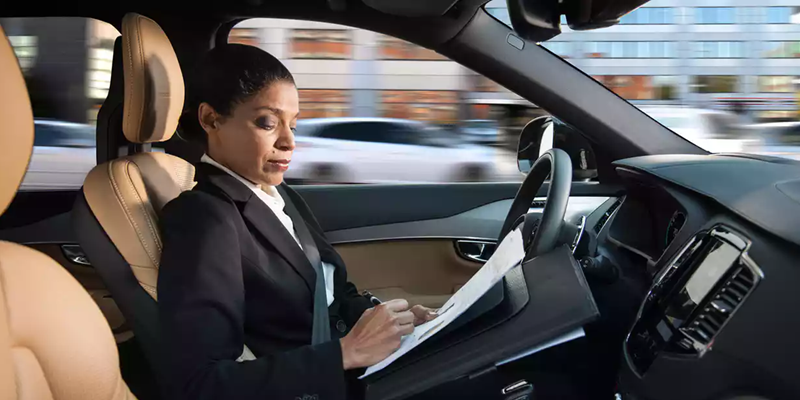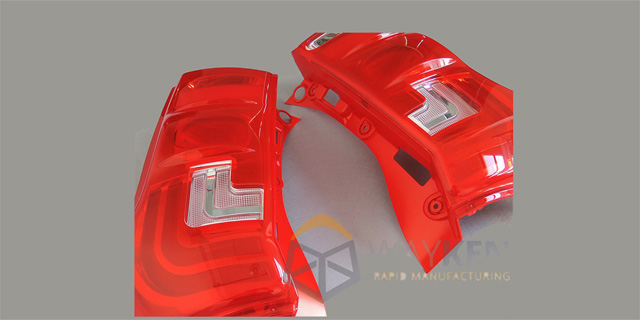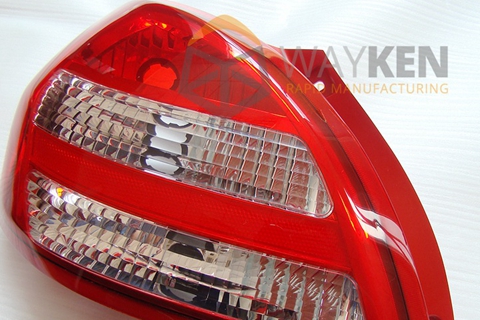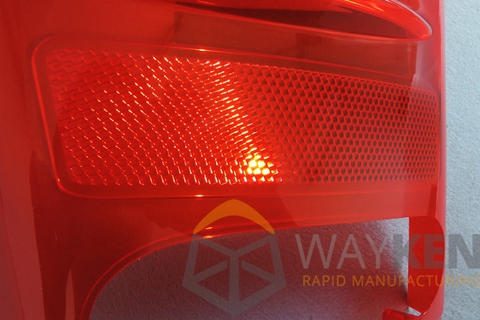Posted on: July 9, 2018, | By Candy, WayKen Marketing Manager
Automobile design is supposedly one of the hardest in modern industry. New models are created yearly and the development time for them must be shorter and shorter to meet market demands. In order to estimate the performance and interaction of every element in the car, automotive prototypes have to be made at several stages of the model development. Automobile lamps serve an important purpose of telling other drivers what the car is going to do next or lighting the path at night. Rear light lamps usually serve the first purpose, while front lamps serve the second. This makes rear view lighting reliability a very important requirement for any car. Let us get to know how rear view light prototype is formed in automotive design.
Rear Lighting Systems
Rear lights were first developed at the beginning of the 20th Century when the number of cars on the roads became considerable. It was too early for LED lights then and electricity in general, so first rear light lamps were oil lamps. The lights didn’t have turn signals or brake signals then, those appeared 20 years later, about the time when electricity was first implemented into cars. Since then, rear lights have made a tremendous technological jump. Modern rear lights is a highly developed complex system that is used as a crucial part of car performance and design.
Engineering Prototypes
During the design and pre-production processes, a number of prototypes have to be made in order to verify the product. At the initial stages of product development, the functionality of the product or its image have to be verified. So, a prototype that partially represents the end product is manufactured. In the first case, the prototype for rear lights will most probably look like a bunch of wires connected to some LED lamps, which can be switched on in the required order. In the second case, the rear light prototype will probably include just the lens of the lamps, which represents the enclosure of the lamp, basically, how it will look in the car. Only one or two examples of the product are usually created here.
This stage concludes with engineering verification tests. During those, rear lamps are tested for the brightness of their light, their functionality and for other basic functional parameters.
Design Validation Prototypes
Once the initial functionality of the product had been confirmed, design verification starts. This stage is aimed at optimizing the geometry of the product and for the first time, the assembly is checked. It is often so, that the first assembly meets a lot of problems and some corrections need to be made. Once the imperfections have been established, they are corrected in the design and the product prototype must be re-manufactured to check its design again as other problems may arise as the result of the corrections. This is an iterative process. Usually, not more than 20 prototypes are made at this stage.
Results of design verification tests include the cosmetic and environmental values of the product. In addition, strength tests are conducted at this stage. For rear lamps, they mostly consist of impact tests. Some hard objects are thrown a the lens to see if it will withstand the hit. At this stage, some materials can be changed to suit the needs of the manufacturers better.
Production Validation Prototypes
This stage takes place after the manufacturing process has been developed. It is basically the first try to manufacture the product as it would be manufactured in mass production. It means that all the expensive tooling has to be manufactured already. Why would the tooling be manufactured if the product is not in mass production yet? What if something changes and the tooling becomes obsolete? Well, the thing here is that production validation is aimed at optimizing the manufacturing process. The design is usually not changed. Unless some unexpected and crucial mistakes have appeared at this stage which usually doesn’t happen because the manufacturability of the product is proved at the previous stage. This stage includes up to a 1000 products to be made.
Methods For Rear Lamps Manufacturing
Different stages of lights development usually use different ways to manufacture prototypes.
At the first stage, there may be the most iterations as the manufacturers have not established the final design yet. So, the prototypes should be remanufactured as fast as possible and may be completely different from each other. The ideal process for this stage is Additive Manufacturing. It is a way to manufacture complex free-form parts without considerable production preparations. The process includes sintering plastic layer-by-layer according to the CAD model of the part.
The second stage requires a number of parts, so 3D-printing may not be as viable anymore. Automotive lights are usually made of transparent plastic ( polycarbonate or PMMA) so it can be cast into urethane molds, which can be created considerably faster and cheaper than injection molds. They can be used for a smaller amount of parts but large amounts are just not necessary at this stage.
The third stage of product verification is basically a test for mass production. Therefore, the expensive steel injection molds are manufactured at this stage and injection molding is the main manufacturing process. In order to get good transparency and surface finish of the lamps, grinding machine tools and polishing methods are implemented, so machine tools are necessary too.
Conclusions
Rear light is an important system in automotive design. It indicates the size of the car at night and tells other drivers what the vehicle in front of them is going to do next. This is why automotive rear lights verification is a complex multi-stage process. The first stage of verification includes determining the basic functionality of a crude prototype. The second stage deals with optimizing and verifying that every part fits together and the whole lamp fits into the car that it will be used for later. And finally, the final stage of verification deals with the imperfections of the manufacturing process. Only having successfully passed all the verification stages can the product be used in the automobile.








